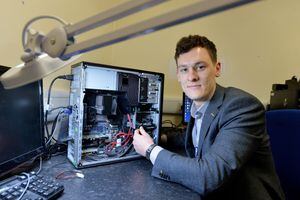Forensics team go digital in their fight against crime
Digital forensics is becoming an increasingly important tool in the front-line fight against crime.

Technology surrounds us 24/7 – we all use computers, make phone calls, send text messages, post on social media, wear smart watches and navigate using sat navs.
But advances in technology mean an increasing amount of crime is now being committed online and even crimes carried out in the physical world will also leave behind a digital footprint.
And it's the job of Staffordshire Police's 35-strong digital forensics unit to extract and analyse this potential evidence on devices such as smartphones, tablets and laptops as well as keep up to with changes in everyday technology.
Steve Cooper, the force's principal digital forensics officer said: "As we are all no doubt fully aware the digital world continues to leap forward year after year resulting in ever advancing technology.
"This technology is fantastic in the consumer market and provides the general public with greater capacity to access services and stay connected with family and friends however this technology also enables criminals to expand their reach and store ever increasing quantities of illegal material."
Digital forensics can be used to provide evidence to support or refute an allegation, a version of events and a person’s involvement in an offence.
Evidence from mobile phones can play a critical role in criminal investigations and all kinds of information can be gleaned from them, says Mr Cooper.
"People have stopped using pen and paper as much. These days phones aren't just for placing a phone call it's way of people living their life," he adds.
From examining a phone, the team can understand more about the owner's life including their schedule, who their friends and family are and what hobbies they have as well as seeing their photos and videos. "They are a window into somebody's life," says Mr Cooper.
Sadly, a large proportion of the units case work is connected with child exploitation as well as acts of extreme violence.
"They are looking at the worst of humanity. In one case they could be looking at two to five million pictures. They won't all be indecent but they will look through every one to find the ones that are and that's pretty intense, We have robust welfare provision in place and they are required to see a counsellor every three months," says Mr Cooper.
The unit is also bolstered by the work of students from Staffordshire University as part of Staffordshire Forensic Partnership which began in 2016.
The programme was set up to exchange ideas between academia and policing and to deliver leading technology and services in forensics. Students participate in six-week or three-month placements and come from traditional and digital forensics backgrounds.
Students have attended crime scenes and conducted research and testing of new equipment. They have also introduced new ideas, such as 360-degree filming which captures evidence and allows investigators to return to a virtual crime scene.
Others have tested equipment which searches for ‘invisible’ evidence, such as firearms residue and faint blood spots at crime scenes and evidence gathering from devices such as fitness apps.
Mr Cooper says the students offer invaluable support and carry out research that his team wouldn't have time to do.
With the digital world ever evolving, it also enables them to keep pace with technology and those who want to use it for criminal gains.
"We're always in a game of catch up but it's a game I think we do quite well at," says Mr Cooper.





